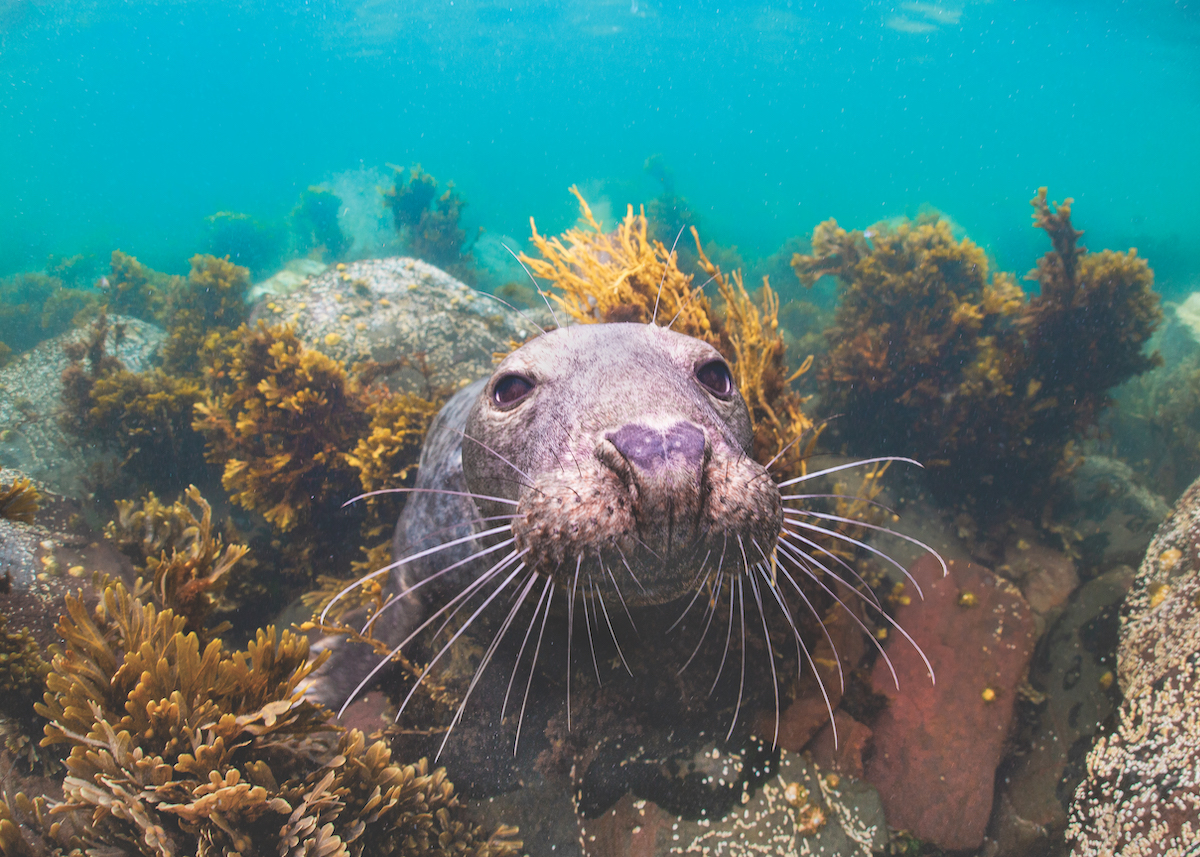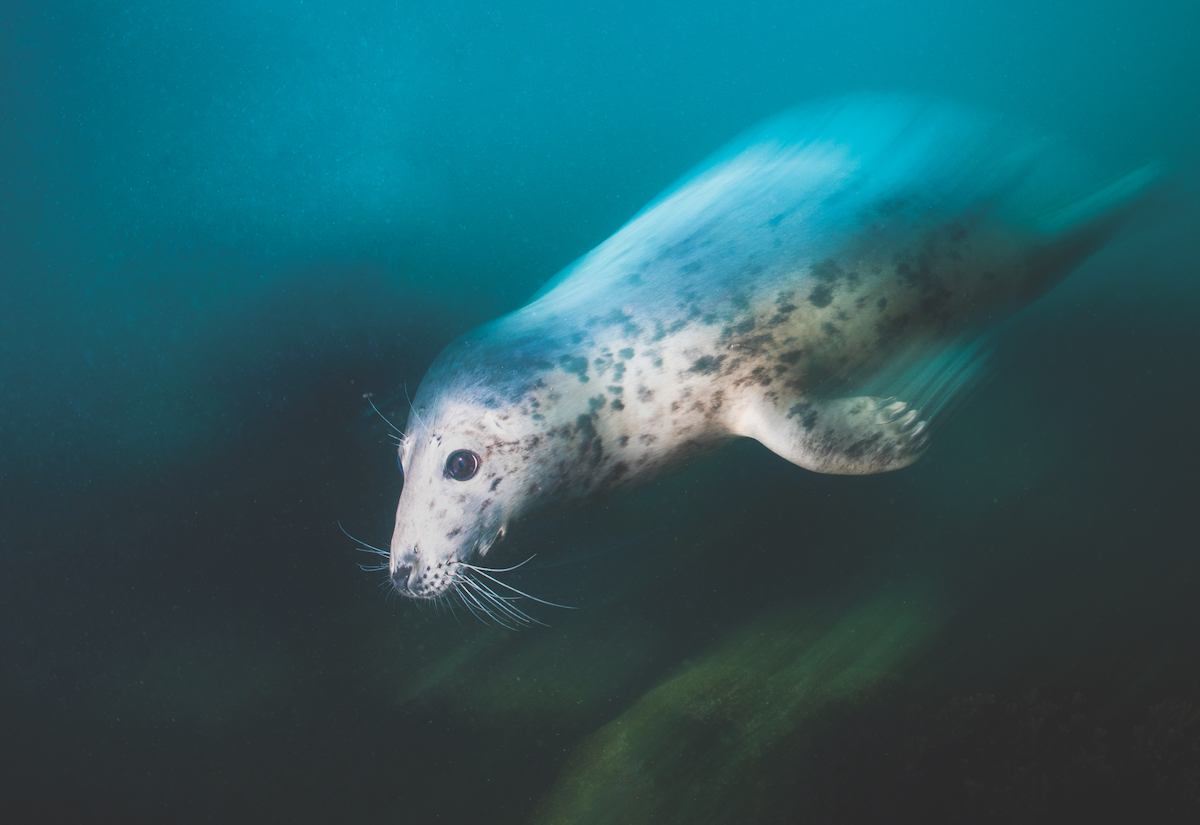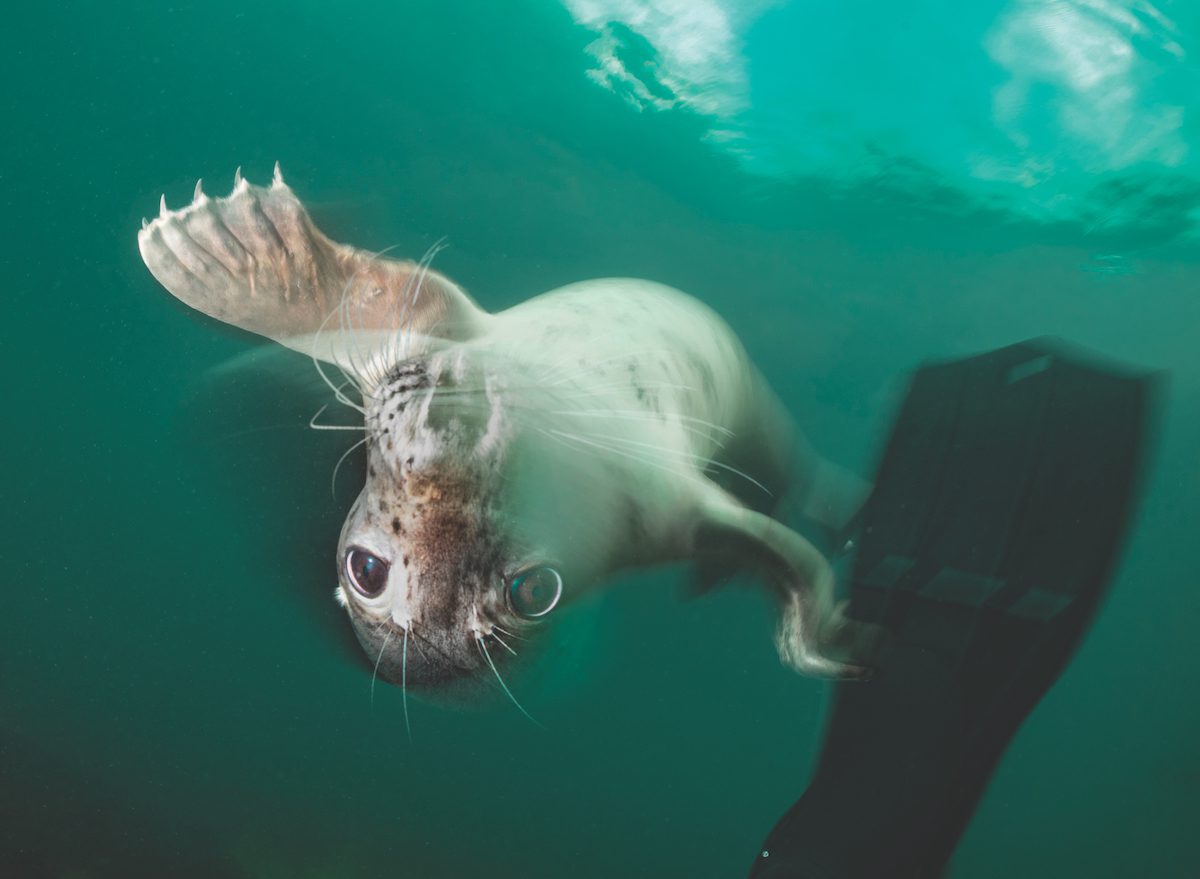Photographs by Martyn Guess.
In these surreal Covid-19 times, I have not been able run my normal overseas photographic workshops and all of them have been postponed until 2021, when hopefully safe travel will be back on the agenda and my students and I can once again dip our toes in warm water. Yet despite these unprecedented times, 2020 has given me seven full days of diving with seals, plus photographing grey seal colonies and experiencing the best way of getting up close to these amazingly friendly and photogenic animals!
At the beginning of the 2020 summer, I made a conscious decision to spend as much time as I could under the surface of British waters when UK diving opened up again. Safe to say that the summer window of relative freedom, before the regional restrictions that we are currently in the middle of arrived, enabled me to do more UK diving than I have ever done in one summer.
I was able to travel to some great diving locations, and in particular I found myself in the sea around Lundy Island in the Bristol Channel for five days of diving in July and then in early September at the opposite end of the country at the Farne Islands, off the coast of Northumberland, for a couple more days in the water. The conditions that I experienced in these locations were at opposite polls, with relatively dark light and poor visibility at Lundy and bright sunshine and very clear visibility in the Farnes. I therefore had to use different photographic techniques to get some images that I am happy with, and thought that I would share them with you.

Diving with seals – Top photography tips.
The majority of the seal interactions that we have in the UK are in relatively shallow water around the rocks where the seals haul themselves out onto at low tide. Being shallower means photography is a little easier, as the ambient light tends to be brighter. My first piece of advice is to take yourself closer to the shallows when you are diving with seals, so that at least you have the light advantage. It is then in the lap of the Gods, whether the seals are going to be interested in interacting with you or not.
The locations with the seal colonies are not zoos and they are of course wild animals and their behaviour can change from day to day. When the presence of seals and close interactions are a little slow, don’t be tempted to chase the opportunities because they just won’t happen in my experience. My friend Alex Mustard adopts a technique of actually ignoring the seals and not even looking at them when he goes diving with seals. When the action was slow when we were diving together in the Farnes, he appeared to look the other way when the seals passed in the distance. Of course, he was actually looking at them out of the corner of his eye!
Grey seals are incredibly curious animals and if nobody is paying them attention, they will want to come in closer to see why you aren’t interested. Take your time and don’t immediately start shooting as this will probably frighten them away. Eventually they will come in really close and even start mouthing your camera or your fins and slowly you can start to take some pictures.
When we arrived at the site we were going to dive at the Farnes, there were loads of seals around at the surface, but frustratingly they just disappeared when we were diving. We were not sure why – some thought that there was a large shoal of herring offshore and they had gone off to hunt. We persevered and while in only 3.5m of water I swam around not seeing many seals. Eventually the odd individual came into the middle distance. I ignored them and hey presto after a few minutes, one pup came in closer to look at me.

It seems that I was right by his favourite scratching rock – the place he loved to come to and rub his body against the smooth rock. I just stayed still occasionally looking at him and taking the odd shot until he was entirely comfortable with me being there. After a few minutes of scratching he would dash away or up to the surface but quickly return and on each occasion, he got more confident and even closer. I had 45 minutes with this little chap until I had to return to the boat.
The main reason I believe the interaction went on for so long was very fortuitus for me. I was having a problem with my flash trigger and the only way I could shoot was with ambient light. Being a bright sunny day and only in 3.5m of water the conditions were ideal to shoot only with natural light. I didn’t even have my strobes attached. Most of the time as photographers we tend to have our strobes attached and ready for use and it is not often that we try ambient light only dives. I can totally recommend you try. I set my camera up to shoot silently and on continuous shutter release – the little guy didn’t even know I was taking photographs!

In a situation like this, it is important to get the sun on your back as being so shallow the subject will be fully lit. You don’t have the ability to flash fill shadows, so it is important to get in the right position and shoot slightly downwards, so that you are not shooting into shadow areas. I also got the background water colour just how bright I wanted it by adjusting the camera speed.
As I was shallow and conditions were bright, I needed to shoot with a faster speed to darken the water colour and this speed was faster than the maximum speed my strobes would normally sync to (1/320th Sec), so shooting without strobes I was able to set the speed at what I needed, which was 1/500th of a second. I was using the Nauticam WACP (wide-angle corrector port) so could happily shoot at F8 or even more open and get good corner sharpness, but anything from F8 to around F14 would work okay behind a dome port. The focus was set to full auto, which on my camera gave me 153 focus points and all the images I took were sharp.
Most photographers with a seal as the main subject will try to get as close as possible. While these are great portraits to take and the audience definitely will engage with a close up, try to balance your portfolio of seal images. You should try to have some wider shots with the seal maybe in the middle ground showing off its habitat. This is so much easier in bright conditions as due to the nature of the subject being further away you can only use ambient light as flashlight falls off quickly underwater. Being shallow also provides great opportunities to show off the underside of the surface and also reflections.

When I went to Lundy Island the sun decided not to come out and it was raining for some of the time we were diving. The conditions were totally different from the Farnes. This time, luckily, my strobes were working fine! As the water background was really dark it was necessary to get very close to the seals and use strobes to light them. I remembered a similar situation whilst diving with Caribbean reef sharks in the Bahamas when it was very overcast at the surface and relatively dark underwater. We used the opportunity to try very slow shutter speeds to try and get some movement blur into our images. I loved the look of the images I took in the Bahamas – they are some of my favourite shark shots, so I decided to try this technique on the seals.
I set the camera speed to 1/8th Sec then an aperture of around F8 and selected an ISO to give me a good exposure (Use the Histogram in your camera to make sure the exposure is correct). As you are shooting with a slow speed you need to be careful of the power that your strobes are set to and the amount of strobe light hitting the subject, so again check histograms to make sure the underbelly or top of the head of the seals are not burnt out. If so, dial down the strobes. With motion blur on potentially fast subjects like seals, set your camera to front curtain sync. This fires the strobe at the beginning of the exposure and then pan your camera through the subject, eventually overtaking it. The image will show streaks of movement behind the subject, emphasizing the speed it is moving at.

If the subject is not moving very quickly then set to rear curtain sync and hold the camera still while the subject moves through the frame. When panning I tend to shoot from the hip as it were – it’s a bit hit or miss, but when you get the whole of the subject in the frame with some movement streaks it will give a different look to standard seal images. This technique is possible with most camera types, as long as you can use manual exposure mode and select front or rear curtain, so check out your camera manual. Shooting from the hip while panning is best tried with a wide -angle lenses or your zoom lens set to wide if using a compact.
Remember when shooting close up shots of seals, move your strobes closer to the housing as you get closer. If you are lucky enough to get the seal nibbling your dome port, then unless your strobes are really close in you risk underlighting the main part of the subject’s face, leaving it in shadow. The underbellies of seals are normally quite light so set your strobe positions in a 10 and 2 (like a clock face) position to avoid burning out the whitish fur. As with all animals and fish, it is important where possible to get good eye contact as this will help people looking at your images to engage with the subject and makes for a more memorable shot.
Next time you are lucky enough to enjoy what is probably one of the best reasons to dive in UK waters (which hold a significant part of the world’s grey seal population), try some of these techniques and I guarantee they will help your images.

Join My Escorted Trips
Want to learn how to take or improve your underwater images? Join my photo specific trips! These trips are meticulously planned for the best destinations at the best time of year, where the conditions should be perfect for building a portfolio of great images. The workshops, which are for all levels of experience but mainly aimed at people with a few trips under their belts, include classroom sessions and presentations as well as in-water help and guidance, all done in a relaxed and non-competitive friendly environment. Please contact the Scuba Travel team, or check out their website Scubatravel for details.
Biography – Martyn Guess.
Martyn has been diving for over 30 years and taking underwater images for nearly as long. He is a well know and successful underwater photographer with many successes in National and International competitions and regularly makes presentations to Camera and Photography clubs and Dive shows as well as The British Society of Underwater Photographers (BSOUP)and other underwater photography groups. Today he shares his passion and knowledge – As well as teaching personalized underwater photography courses he leads overseas workshop trips for Scuba Travel and his articles regularly appear in Scuba Diver Magazine.








